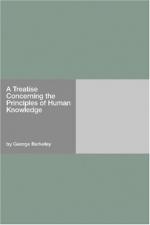112. Motion, whether real or apparent, relative.—But, notwithstanding what has been said, I must confess it does not appear to me that there can be any motion other than relative; so that to conceive motion there must be at least conceived two bodies, whereof the distance or position in regard to each other is varied. Hence, if there was one only body in being it could not possibly be moved. This seems evident, in that the idea I have of motion doth necessarily include relation.
113. Apparent motion denied.—But, though in every motion it be necessary to conceive more bodies than one, yet it may be that one only is moved, namely, that on which the force causing the change in the distance or situation of the bodies, is impressed. For, however some may define relative motion, so as to term that body moved which changes its distance from some other body, whether the force or action causing that change were impressed on it or no, yet as relative motion is that which is perceived by sense, and regarded in the ordinary affairs of life, it should seem that every man of common sense knows what it is as well as the best philosopher. Now, I ask any one whether, in his sense of motion as he walks along the streets, the stones he passes over may be said to move, because they change distance with his feet? To me it appears that though motion includes a relation of one thing to another, yet it is not necessary that each term of the relation be denominated from it. As a man may think of somewhat which does not think, so a body may be moved to or from another body which is not therefore itself in motion.




